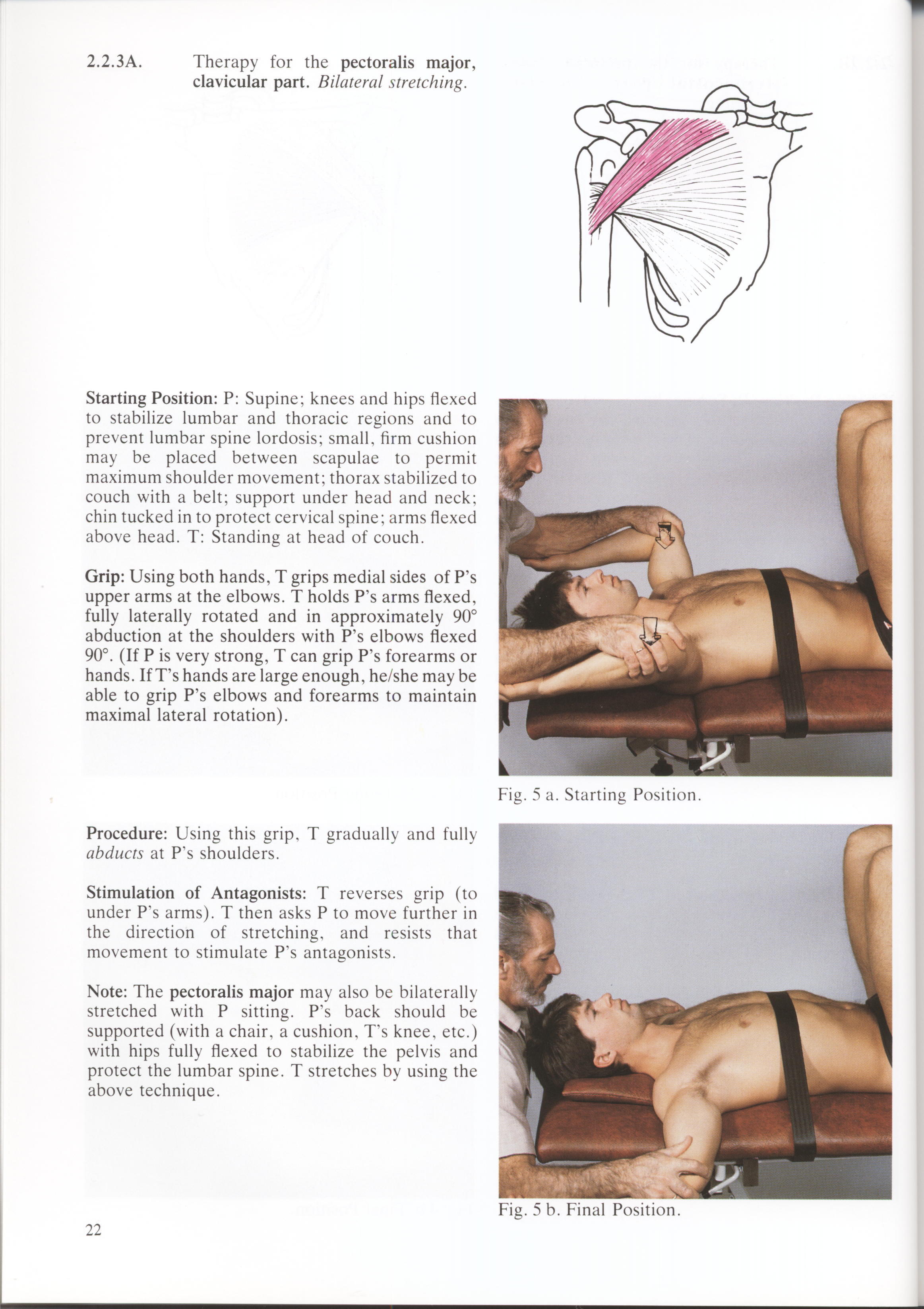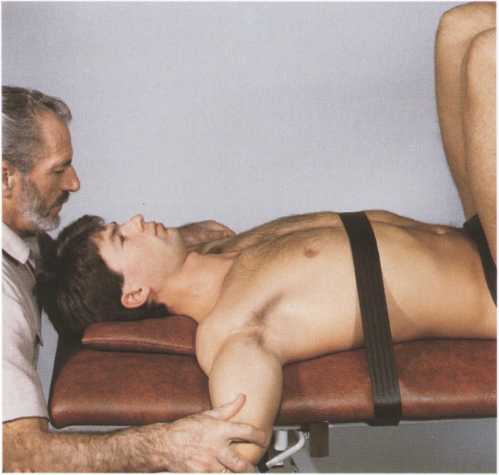22 (935)

2.2.3A.
Therapy for the pectoralis major,
clavicular part. Bilateral stretching.

Starting Position: P: Supine; knees and hips flexed to stabilize lumbar and thoracic regions and to prevent lumbar spine lordosis; smali, firm cushion may be placed between scapulae to permit maximum shoulder movement; thorax stabilized to couch with a belt; support under head and neck; chin tucked in to protect cervical spine; arms flexed above head. T: Standing at head of couch.
Grip: Using both hands, T grips medial sides of P’s upper arms at the elbows. T holds P’s arms flexed, fully laterally rotated and in approximately 90° abduction at the shoulders with P’s elbows flexed 90°. (If P is very strong, T can grip P’s forearms or hands. If T’s hands are large enough, he/she may be able to grip P’s elbows and forearms to maintain maximał lateral rotation).

Fig. 5 a. Starting Position.
Procedurę: Using this grip, T gradually and fully abducts at P's shoulders.
Stimulation of Antagonists: T reverses grip (to under P’s arms). T then asks P to move further in the direction of stretching, and resists that movement to stimulate P's antagonists.
Notę: The pectoralis major may also be bilaterally stretched with P sitting. P's back should be supported (with a chair, a cushion, T’s knee, etc.) with hips fully flexed to stabilize the pelvis and protect the lumbar spine. T stretches by using the above technique.

Fig. 5 b. Finał Position.
22
Wyszukiwarka
Podobne podstrony:
23 (884) 2.2.3B. Therapy for the pectoralis major, clavicular part. Unilateral stretching. Starting
21 (955) 2.2.2B. Therapy for the pectoralis major, sternocostal part. Unilateral stretching. St
57 (309) 3.3.7. Therapy for the extensor digitorum communis. (Middle finger only). Starting Position
82 (183) 3.10.2B. Therapy for the scalenus anterior and medius. AIternative grip. Starting Position:
27 (713) 2.2.6 Therapy for the pectoralis minor. Starting Position: P: Supine; scapula over side of
33 (622) 2.3.5A. Therapy for the rhomboidei major and minor. P prone. Starting Position: P: Prone; r
34 (543) 1 2.3.5B. Therapy for the rhomboidei major and minor. P lying on side. Starting Position: P
26 (738) 2.2.5. Therapy for the teres major. Starting Position: P: Supine; knees a
44 (440) 2.12.1. Therapy for the trapezius, descend- ing part. Starting Position:
24 (831) 2.2.4A. Therapy for the latissimus dorsi. Bilateral stretching. Starting Position: P: Supin
1. INTRODUCTION The results of various accident scenario simulations for the two major MHTGR variant
56 (314) 3.3.6. Therapy for the extensor indicis. Starting Position: P: Supine; forearm flexed and f
58 (288) 3.3.8. Therapy for the extensor digiti minimi. Starting Position: P: Supine; arm flexed app
59 (281) 3.3.9. Therapy for the supinator. Starting Position: P: Supine; arm flexed approx-imately 9
60 (279) 3.3.10. Therapy for the extensor carpi ulnaris. Starting Position: P: Supine; arm flexed ap
61 (266) 3.3.11. Therapy for the flexor carpi ulnaris. Starting Position: P: Supine; arm flexed appr
62 (264) 3.3.12. Therapy for the flexor carpi radialis. Starting Position: P: Supine; arm flexed app
64 (249) 3.3.14. Therapy for the pronator teres, humerał head. Starting Position: P: Supine; arm fle
65 (244) 3.3.15. Therapy for the pronator teres, ulnar head and the pronator quadratus. Starting Pos
więcej podobnych podstron